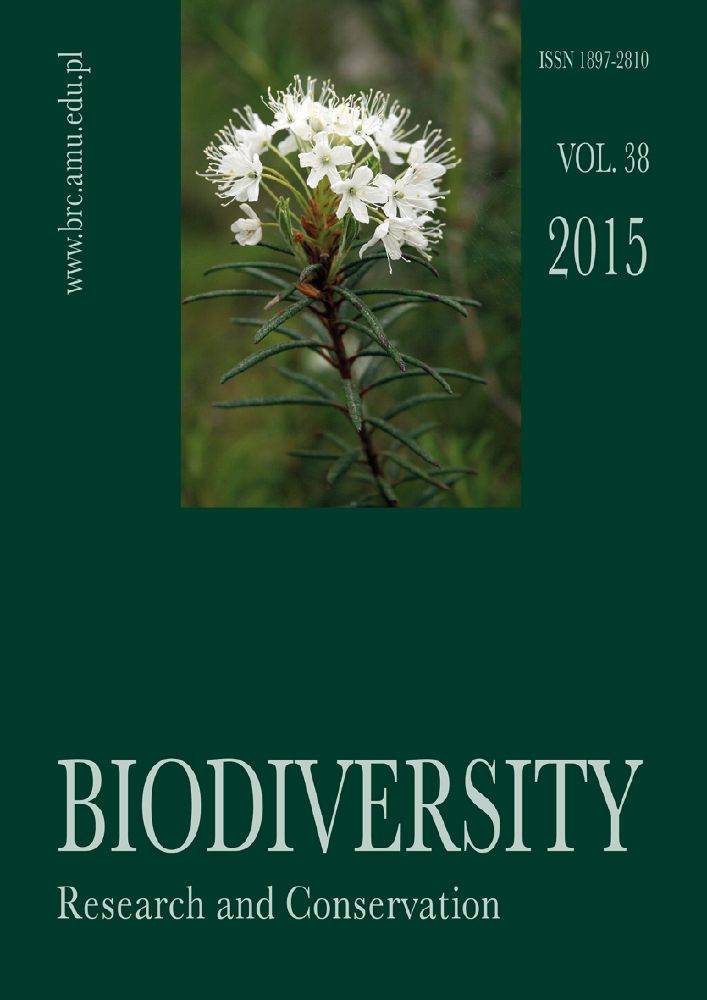Abstract
Raised and transitional peat bogs, despite their considerable resistance to synanthropization, as a result of anthropogenic transformations are exposed to the colonisation by alien species. One of them is the peatland “Roby”, where, in the years 2007-2009 and 2014, floristic, phytosociological and soil studies were carried out in order to record the signs of ongoing synanthropization. Conducted observations and analyses indicated that the expansion of willows has taken place and at present they occupy a large part of the bog, encroaching into bog birch forest and successfully competing with Myrica gale. Progressive peat mineralisation and constructed surfaced roads within the bog, contributed to the appearance and wide distribution of synanthropic species, such as: Urtica dioica, Impatiens parviflora and Spiraea salicifolia. Raised bog communities and their characteristic species occur on a few fragments of the bog, in north-western part, where water regime is shaped mainly by precipitation and peat deposit is fairly well-preserved. At the same time, in the patches of these communities, a distinct unfavourable increase in the share of Molinia caerulea is observed.
References
Budyś A. 2006/2007. Anthropophytisation process in vascular plants flora of peatlands in the coastal zone exemplified by the east part of Kashubian Coastal Region. In: T. S. Olszewski, R. Afr anowicz & K. Bociąg (eds.). Contemporary trends of botanical research - on Professor Hanna Piotrowska 80th birthday anniversary. Acta Bot. Cassub. 6: 121-130.
Budyś A. 2008. The synanthropisation of vascular plant flora of mires in the coastal zone (Kashubian Coastal Region, N Poland) - range, reasons for, and spatial characteristics. Monogr. Bot. 98: 1-55.
Fałtynowicz W. 2003. The lichenes, lichenicolous and allied fungi of Poland - an annotated checklist. In: Z. Mirek (ed.). Biodiversity of Poland, 6, 435 pp. W. Szafer Institute of Botany, Polish Academy of Sciences, Kraków.
Fojt W. & Harding M. 1995. Thirty years of change in the vegetation communities of three valley mires in Suffolk. J. Appl. Ecol. 32: 561-577.
Herbichowa M., Pawlaczyk P. & Stańko R. 2007. Conservation of Baltic raised bogs in Pomerania, Poland. Experience and Results of the LIFE04NAT/PL/000208 PLBALTBOGS Project. 148 pp. Published by Naturalists Club Poland (Klub Przyrodników), Świebodzin.
Ilnicki P. 2002. Torfowiska i torf. 606 pp. Wyd. AR w Poznaniu, Poznań.
Jasnowski M. 1972. Rozmiary i kierunki przekształceń szaty roślinnej torfowisk. Phytocoenosis 1(3): 193-209.
Jasnowski M., Jasnowska J. & Markowski S. 1968. Ginące torfowiska wysokie i przejściowe w pasie nadbałtyckim. Ochr. Przyr. 33: 69-124.
Kalembasa D., Becher M., Pakuła K. & Jaremko D. 2006. Wybrane właściwości fizykochemiczne i chemiczne gleb torfowo-murszowych w dolinie rzeki Liwiec na Wysoczyźnie Siedleckiej. In: T. Brandyk, L. Szajdak & J. Szatyłowicz (eds.). Właściwości fizyczne i chemiczne gleb organicznych, pp. 25-32. Wydaw. SGGW Warszawa.
Liwski S., Okruszko H. & Kalińska D. 1981. Zróżnicowanie zawartości składników chemicznych w organogenicznych utworach glebowych Bagien Biebrzańskich. Zesz. Nauk. AR we Wrocławiu, Rolnictwo 38, 134: 97-109.
Maciak F. 1995. Ocena aktywności biologicznej murszów i torfów na podstawie mineralizacji związków węgla i azotu. Rocz. Gleboz. 46(3/4): 19-27.
Matuszkiewicz W. 2001. Przewodnik do oznaczania zbiorowisk roślinnych Polski. In: J. B. Faliński (ed.). Vademecum Geobotanicum 3, 537 pp. Wyd. Nauk. PWN, Warszawa.
Mirek Z., Piękoś-Mirkowa H., Zając A. & Zając M. 2002. Flowering plants and pteridophytes of Poland. A checklist. In: Z. Mirek (ed.). Biodiversity of Poland, 1, 442 pp. W. Szafer Institute of Botany, Polish Academy of Sciences, Kraków.
Moen A. 1995. Introduction: regionality and conservation of mires. In: A. Moen (ed.), Regional variation and conservation of mire ecosystems. Gunneria 70: 11-22.
Ochyra R., Żarnowiec J. & Bednarek-Ochyra H. 2003. Census Catalogue of Polish Mosses. In: Z. Mirek (ed.). Biodiversity of Poland, 3, 372 pp. Polish Academy of Sciences, Institute of Botany, Kraków.
Paulissen M. P. C. P., van der Ven P. J. M., Dees A. J. & Bobb ink R. 2004. Differential effect of nitrate and ammonium on three fen bryophyte species in relation to pollutant nitrogen input. New. Phytol. 164: 451-458.
Pawlaczyk P. 2009. Torfowiska w obliczu zagrożeń powodowanych przez rozwój obcych gatunków inwazyjnych. In: Z. Dajdok & P. Pawlaczyk (eds.). Inwazyjne gatunki roślin ekosystemów mokradłowych Polski, pp. 19-23. Wyd. Klubu Przyrodników, Świebodzin.
Pawlaczyk P., Herb ichowa M. & Stańko R. 2005. Ochrona torfowisk bałtyckich. Przewodnik dla praktyków, teoretyków i urzędników. 190 pp. Wyd. Klubu Przyrodników, Świebodzin.
Prajs B., Sotek Z. & Stasińska M. 2006. Degradation of peatland vegetation on the Reptowo bog and an attempt of its renaturalization. Polish Journal of Environmental Studies 15, 5d(1): 161-165.
Regulation 2007. Regulation of West Pomeranian Province Governor No 54/2007 of 27 September 2007 on the nature reserve “Roby”. J. L. of West Pomeranian Province 2007, No 102, item 1752.
Sadowska A. 2011a. The vascular plant flora of peatlands submitted to anthropic pressure in the Równina Błot Przymorskich microregion and the Płutnica river valley (the Pobrzeże Kaszubskie region, N Poland). Acta Bot. Cassub., Monogr. 4: 1-166.
Sadowska A. 2011b. Gatunki synantropijne we florze roślin naczyniowych torfowisk wysokich i przejściowych Pojezierza i Pobrzeża Kaszubskiego (Polska północna). Acta Bot. Silesiaca 7: 79-95.
Sotek Z. 2010. Distribution patterns, history, and dynamics of peatland vascular plants in Pomerania (NW Poland). Biodiv. Res. Conserv. 18: 1-82.
Sotek Z., Stasińska M., Prajs B., Gamr at R. & Łysko A. 2004. Torfowiska śródpolne województwa zachodniopomorskiego. Woda-Środowisko-Obszary Wiejskie, 4, 2b(12): 211-224.
Stasińska M. 2011. Macrofungi of raised and transitional bogs of Pomerania. Monogr. Bot. 101: 1-142.
Stasińska M. & Sotek Z. 2010. Zróżnicowanie macromycetes mszaru wrzoścowego Erico-Sphagnetum medii (Schwic. 1933) Moore 1968 - wstępne wyniki badań. IMUZ. Woda - Środowisko - Obszary Wiejskie, 10, 3(31): 271-282.
Succow M. & Joosten H. (eds.). 2001. Landschaftsökologische Moorkunde. 2. völl. bearb. Aufl. E. Schweizerbart’sche Verl., Stuttgart.
Tomassen H. B. M., Smolders A. J. P., Limpens J., Lamers L. P. M. & Roelofs J. G. M. 2004. Expansion of invasive species on ombrotrophic bogs: desiccation or high N deposition? J. Appl. Ecol. 41: 139-150.




